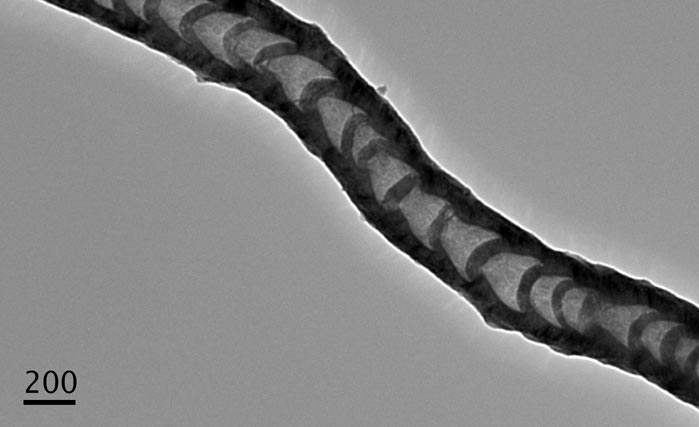From recycling to upcycling: A smarter way of dealing with plastic

A carbon nanotube created through the new upcycling method. Image magnified 35,000 times.
Credit: RMIT University
Researchers have developed a clean and cost-effective way to upcycle used plastic, transforming it into valuable nanomaterials and high-quality fuel.
Key points
- New tech produces carbon nanotubes and clean liquid fuel from used plastic
- Smart solution for upcycling plastic and agricultural waste simultaneously
- Circular economy approach to help turn two massive waste streams into genuine revenue
Globally only about 20% of waste plastics are recycled. Boosting that figure remains a challenge as recycling plastic cleanly can be expensive and usually produces lower-value products, often making it financially unviable.
The new method from researchers at RMIT University in Melbourne, Australia, can produce high-value products from plastic – carbon nanotubes and clean liquid fuel – while simultaneously upcycling agricultural and organic waste.
The team’s two-step process, revealed in the Journal of Environmental Management, converts organic waste into a carbon-rich and high-value form of charcoal, then uses this as a catalyst to upcycle the plastic.
Lead researcher Associate Professor Kalpit Shah said upcycling two massive waste streams through one circular economy approach could deliver significant financial and environmental benefits.
“Our method is clean, cost-effective and readily scaleable,” Shah said.
“It’s a smart solution for transforming both used plastic and organic waste – whether tonnes of biomass from a farm or food waste and garden clippings from household green bins.
“We hope this technology could be used in future by local councils and municipal governments to help turn this waste into genuine revenue streams.”
High-value nanomaterials
The new plastic upcycling approach offers a sustainable alternative for the production of carbon nanotubes (CNTs).
These hollow, cylindrical structures have exceptional electronic and mechanical properties, with applications across a broad range of sectors including hydrogen storage, composite materials, electronics, fuel cells and biomedical technologies.
Carbon nanotubes are in growing demand, particularly in aerospace and defence, where they can facilitate the design of lightweight parts. The global market for CNTs has been projected to reach $5.8 billion by 2027.
Turning old into new
The new method starts with converting agricultural or organic waste to biochar – a carbon-rich form of charcoal often used for improving soil health.
The biochar is used to eliminate toxic contaminants – such as Poly-cyclic Aromatic Hydrocarbons, known as PAHs – as the waste plastic is broken down into its components of gas and oil.
The process eliminates those contaminants and convert plastics into high-quality liquid fuel.
At the same time, the carbon in the plastic is converted into carbon nanotubes, which coat the biochar.
These nanotubes can be exfoliated for use by various industries or the nano-enhanced biochar can be used directly for environmental remediation and boosting agricultural soils.
The study is the first to use low-cost and widely available biochar as a catalyst for making contaminant-free fuel and carbon nanomaterials from plastic.
Shah, the Deputy Director (Academic) of the ARC Training Centre for Transformation of Australia’s Biosolids Resource at RMIT, said while the study only investigated one type of plastic the approach would be applicable to a range of plastic types.
“We focused on polypropylene as this is widely used in the packaging industry,” he said.
“While we need to do further research to test different plastics, as the quality of the fuel produced will vary, the method we’ve developed is generally suitable for upcycling any polymers – the base ingredients for all plastic.”
Hyper-efficient reactor
The experimental study conducted at lab scale can also be replicated in a new type of hyper-efficient reactor that has been developed and patented by RMIT.
The reactor is based on fluidised bed technology and offers significant improvement in heat and mass transfer, to reduce overall capital and operating costs.
The next steps for the upcycling research will involve detailed computer modelling to optimise the methodology, followed by pilot trials in the reactor.
The team from RMIT’s School of Engineering is keen to collaborate with plastic and waste industries to further the research and investigate other potential applications of the upcycling method.
The research was supported through an Australian Research Council DECRA Fellowship.
‘Conversion of pyrolytic non-condensable gases from polypropylene co-polymer into bamboo-type carbon nanotubes and high-quality oil using biochar as catalyst’, with RMIT co-authors Dr Savankumar Patel, Pobitra Halder, Dr Sazal Kundu, Mojtaba Hedayati Marzbali, Ibrahim Gbolahan Hakeem, Dr Biplob Kumar Pramanik, Dr Ken Chiang and Tejas Patel, is published in the Journal of Environmental Management (DOI: 10.1016/j.jenvman.2021.113791).
Journal: Journal of Environmental Management
DOI: 10.1016/j.jenvman.2021.113791
Article Title: Conversion of pyrolytic non-condensable gases from polypropylene co-polymer into bamboo-type carbon nanotubes and high-quality oil using biochar as catalyst
Media Contact
Gosia Kaszubska
RMIT University
gosia.kaszubska@rmit.edu.au
Cell: +61417510735
All latest news from the category: Ecology, The Environment and Conservation
This complex theme deals primarily with interactions between organisms and the environmental factors that impact them, but to a greater extent between individual inanimate environmental factors.
innovations-report offers informative reports and articles on topics such as climate protection, landscape conservation, ecological systems, wildlife and nature parks and ecosystem efficiency and balance.
Newest articles

Innovative 3D printed scaffolds offer new hope for bone healing
Researchers at the Institute for Bioengineering of Catalonia have developed novel 3D printed PLA-CaP scaffolds that promote blood vessel formation, ensuring better healing and regeneration of bone tissue. Bone is…

The surprising role of gut infection in Alzheimer’s disease
ASU- and Banner Alzheimer’s Institute-led study implicates link between a common virus and the disease, which travels from the gut to the brain and may be a target for antiviral…

Molecular gardening: New enzymes discovered for protein modification pruning
How deubiquitinases USP53 and USP54 cleave long polyubiquitin chains and how the former is linked to liver disease in children. Deubiquitinases (DUBs) are enzymes used by cells to trim protein…



